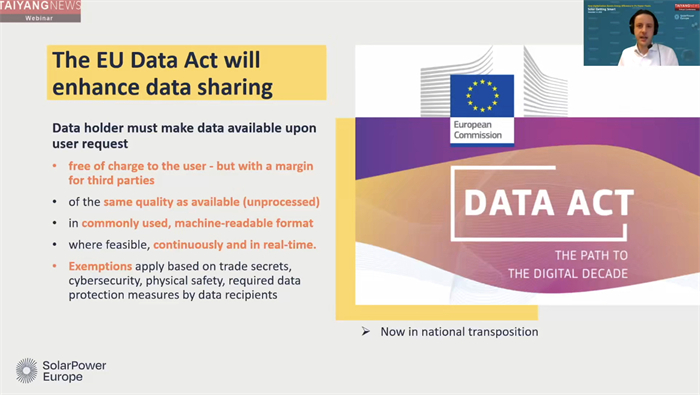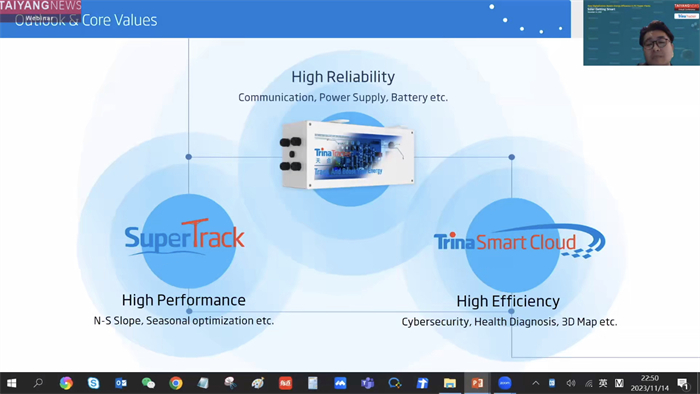
The webinar moderated by Michael Schmela of TaiyangNews had in attendance Miguel Miguel of PVcase, Sun Kai of TrinaTracker and Jan Osenberg of SolarPower Europe.
Changzhou, China, November 14 –, SolarPower Europe and PVcasehave taken part in an online seminar with the theme ”How to improve the efficiency and reliability of photovoltaic power plants through digitalization”, organized by Taiyang News. Kai Sun Kai, head of smart tracker control systems of TrinaTracker, Jan Rosenberg, policy adviser of SolarPower Europe, and Miguel Herrero, market and insight analyst of PVcase, discussed the growing digital needs of the solar photovoltaic industry.
As with almost all industries, digitalization has a deep impact on solar energy providers. In fact, it is fast becoming an integral part of managing and operating an entire PV system in terms of monitoring and optimization, predictive maintenance and demand response.
However, its use is not limited to the management of a power plants. The use of smart trackers, for instance, represents digital technology. Similarly, those in the field are working toward incorporating digital tools from when solar power plants are being designed. This digitalized ecosystem is aimed at making solar smart.

Jan Osenberg of SolarPower Europe said the solar industry should treat the upcoming EU Data Act as an opportunity to prepare for a digitalized ecosystem.
Talking of the evolving policy framework nudging the industry toward digitalization, Jan Osenberg, a policy adviser with SolarPower Europe, looked at the opportunities it presents for PV system integration and optimization.
All of this becomes extremely important, he said, as solar power capacity continues to grow, with new installations expected to reach 341 GW globally this year. SolarPower Europe forecasts that in a medium scenario the world should comfortably pass the 2 TW milestone in early 2025. The EU alone is forecast to double its total installed capacity from the 260 GW expected at the end of this year to almost 600 GW DC by 2027. Availability of data via digital platforms will make it easier for developers as well as authorities to compare various projects to see what works and what does not.
Similarly, municipalities at the front line need to go digital to enable project developers to plan and design their facilities with accurate information fed into the system, Osenberg said. This will also reduce complexity as smart energy booms by optimizing self-consumption and remove barriers to new market models for better and enhanced solar integration.
The solar PV industry must prepare itself to define sector-specific guidelines and show what it should mean for the entire value chain in terms of roles, rights, responsibilities, standards and communication protocols, he said.

Sun Kai of TrinaTracker said that by using the company’s smart technology tools it can offer customized solutions for end users, thus proving the benefits of a digitalized solar system.
Sun Kai, head of smart tracker control systems of TrinaTracker, explained his company’s digitalized tracker technology to show how it can increase reliability and yields. He pointed to the role of digitalization of big data that has implications for the entire lifecycle of solar power plants, from design, construction and installation, commissioning, extending into operation and maintenance. All of these lead to the realization of a smart energy system.
While traditional tracking systems cannot give full play to power generation potential, the TrinaTracker smart tracking solution with its patent smart control system ensures high reliability, performance and efficiency for solar power plants in times of growing need for quick and customized solutions, Sun said.
The TrinaTracker smart control system contains controller, smart algorithm and cloud platform. The controller offers multiple stable wireless communication methods to fulfil various requirements in different regions, and implements multi-level wind, snow and hail protection to enhance system stability, ensuring reliable operation in extreme conditions. It has been integrated with the smart tracking algorithm SuperTrack to provide advanced tracking capabilities for total solutions.
TrinaTracker’s tracker level SCADA, the cloud platform, can do real-time monitoring and recording of tracker operational data, dynamically display equipment status and transmit operational data to the plant-level SCADA. This data supports fault analysis and daily maintenance, effectively improving operational efficiency.

Miguel Herrero of PVcase said he sees digital twins becoming the key to increasing process efficiencies of solar power systems.
Pointing to the growing complexity of solar power plants with all new technologies, use of trackers, and use of bifacial modules, Miguel Herrero, market and insights analyst with PVcase, said the industry needs to manage data risks in the development and engineering phases of solar PV projects.
Over the past few years, as demand for solar PV has soared, the industry has had to execute projects in a time-bound manner within a competitive environment at lower costs, he said. The software tools the industry has mostly relied on has focused on specific project development steps, not using coordinated data format and structures, Herrero said. It is usually a static file format such as PDF that encapsulates the information. The limited information collection on the equipment used, processes followed and so on are soon lost and shared indiscriminately, exposing a plant and its developer to significant data risks.
The need for the industry today is to have a sophisticated, comprehensive suite of software tools that can improve a project’s design standards and increase process efficiency, Herrero said. Talking of PVcase’s suite of software services, he said its technology can intuitively and quickly identify and analyze sites for developers to build their projects by adding a layer of automation to the latter’s Geographic Information System, thus making the best use of digitalization.
Here there is huge potential for the solar PV industry to utilize digital twin capabilities when it comes to digitalization, which can be used throughout the lifecycle of a PV plant for its optimization, Herrero said.
